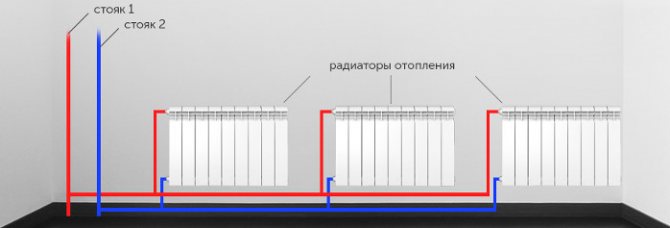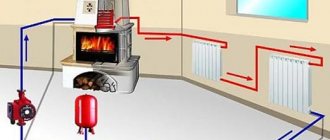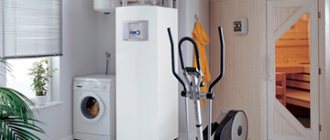Features of the
If there is a desire to reduce financial costs, first of all, you should understand what energy-efficient heating systems are. First of all, they allow more economical use of fuel resources and at the same time maintain the required temperature regime in the premises.
Not one method of providing heat to real estate and not separately taken models of heat generators are suitable for these characteristics. Currently, energy conservation involves the implementation of a whole range of measures aimed at saving money.

They will be different for each real estate object and consumer of thermal energy, but you can decide on the main directions in the implementation of energy saving.
Infrared heating panels
A distinctive feature of this type of heating is the heating of various surfaces, not air. As a result, after a short period of time, all things located in the room turn into small "heaters". It should be noted that the generated radiation is safe for human health.
The main advantages of this technology are:
- high safety performance;
- relatively low cost;
- ease of use;
- 60% savings compared to a conventional heating system.
What is the most profitable fuel
A considerable amount of money from the owners of private real estate is spent on the purchase of energy resources for the upcoming heating season. But different fuels have different efficiency and cost. Currently, the use of main gas is considered to be the most profitable, therefore it is he who is considered the classic raw material for energy-saving heating.
In regions with a lot of forest plantations, firewood is approaching an inexpensive price category, a similar situation is also associated with coal. This is followed by products of industrial processing of wood raw materials and agricultural waste, such as briquettes and pellets.
As for liquid fuel - oil, petroleum products, diesel fuel, etc., as well as liquefied propane - butane, their prices are 5-7 times higher than for gas from trunk networks. And electricity for heating the property will cost ten times more. By the way, the heat pumps used for generation operate on electricity, although it is not consumed much.
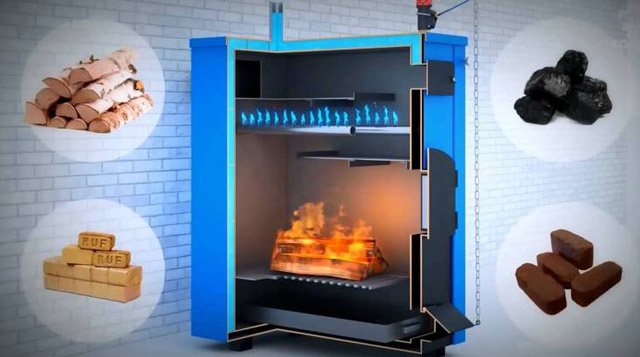

In different regions of the country, the situation with the provision of solid fuel is different. In some localities, it is quite affordable and has a favorable price due to the geographical location of the property. At the same time, the fuel should be brought to other places, otherwise it is reflected in the final costs for heat supply.
The situation with fuel resources is not bad for the owners of farms who have oil cake, husks, shells, or the owners of sawmills, who have access to free production waste - bark, wood chips and sawdust.
The efficiency of each type of fuel primarily depends on its quality characteristics. So when heating with dry wood, more heat energy is generated than when heating with wet raw materials. Hardwoods such as oak give off more heat.


If a liquid fuel is used, for example diesel fuel, then for complete combustion it must contain a minimum amount of impurities and it must be frequently heated. In the event of a voltage drop in the mains, the performance of the heaters decreases.By the way, in order to equip energy efficient heat supply, there is no need to focus exclusively on one type of fuel resource. Parallel connection of heat generators, independently operating on different raw materials, is permissible.
For example, to install energy-saving heating systems, you can use an electric boiler and a solid fuel generator assembled in a single cascade - the first of the devices turns on at night, and the second in the daytime.
Conventional Heating Optimization Tools
Practice shows that the indicators of energy costs for heating systems are largely determined by the quality of the project. The layout of heating pipes, the points of installation of heat-emitting panels, the performance of boiler installations - all this affects the consumption of electricity or fuel materials. Therefore, even at the stage of choosing a heating method, it is desirable at least to correlate the power of the installation with the requirements for the volume of heat transfer. In addition, energy-saving heating based on conventional systems can be realized through the integration of automatic systems. They will help you to achieve rational consumption without user intervention by controlling operating modes.
Optimal fuel consumption
To make the heating of a house really economical, you need to use a heat generator that uses energy most efficiently. This has a lot to do with efficiency. The fact is that modern heating equipment from well-known companies consumes less fuel than similar units of outdated models.
Today, the latest heat generators are presented on the domestic market, providing energy-efficient heating, since they use advanced technologies in their manufacture.
For example, gas condensing boilers additionally extract heat energy from water vapor discharged with the smoke. Their efficiency reaches 110%, resulting in savings of blue fuel up to 15%.


Among wood-fired units, gas generating or pyrolysis boilers can provide the most energy-efficient heating of a private house - their efficiency is close to 92%. In this case, there will also be fuel savings, since this indicator does not exceed 80% for traditional devices.
If the house has radiator heating, and there is no alternative to using electricity, then it is better to consider the option of installing an induction unit, which does not have problems with scale and does not lose efficiency over time. When there are no pipelines and no heating fluid is used, instead of heaters, you can calculate the floor heating system.
Many private homeowners think that heat pumps can provide heating for free. But this is not true, because in order to extract heat from air, water or soil, you still need to expend energy.


For example, even for highly efficient heat pumps, for geothermal plants with vertical probes, submerged in deep wells, the conversion factor is from 3 to 5. This means that it takes 1 kW of electricity to obtain heat energy equal to 3 kilowatts.
To equip this type of energy efficient system will require a large amount of start-up costs - in some cases, turnkey heat pump installation can cost tens of thousands of dollars.
Monolithic quartz electric heaters
Monolithic quartz heaters are small mobile panels that can be evenly distributed around the perimeter of the room.


The surface of monolithic quartz modules does not heat up above 95 degrees, therefore, they are fireproof and do not dry out the air in the room
The source of energy for quartz heaters is electricity, however, they can be used to reduce consumption due to two factors:
- The principle of operation of the device is associated with periodic heating of quartz sand, which is capable of accumulating heat even after a power outage. The operation of the device is similar to the operation of a Russian stove, which is first heated with firewood, and then it slowly cools down, heating the room. The role of firewood is played by a chromium-nickel heating element mounted inside the device and having a long service life.
- A system of quartz modules will be more economical if it is equipped with air temperature controllers. With the help of automatic adjustment, it is easy to achieve the desired temperature, without overheating and excessive heat transfer.
Quartz steel heaters were actively produced in the late 90s of the last century, but they have already won their active consumer. In addition to summer residents who do not permanently live outside the city, the owners of public institutions - schools, kindergartens, libraries - have become interested in heaters. They are also relevant for heating offices that require the installation of a small number of modules: one device heats 15 m³ of space. To provide warmth to a spacious room, a system should be installed from a certain number of parallel-installed panels.
Quartz heaters are perfect for anyone who appreciates ease of use and installation, affordable cost and savings.
Features of the operation of an economical heat generator
In order to equip a truly energy-saving system, it is advisable to adhere to a number of recommendations regarding the selection and operation of boilers:
- You should purchase a heat generator that is optimal in terms of power. An excessive reserve of productivity, as well as its lack, leads to an overexpenditure of the fuel resource.
- Preference should be given to mono-fuel heating units. There is a rule about energy efficiency - universal heating is the enemy of good heating. But, if everyone needs such a device, it is better to give preference to a boiler with separate fireboxes, operating on several types of fuel.
- When the connection of the DHW circuit is required, it is not always necessary to purchase a double-circuit boiler, it will be enough to install an indirect heating boiler in the heating structure. The more accurately the control automation works, the more functional it is, the easier it is to set the most economical mode of operation of the heat generator.


Less fuel is consumed by gas units that have:
- piezo ignition - there is no wick burning in a constant mode;
- modulating burner, thanks to which the performance in the entire range is controlled smoothly.
Competent use of the received heat
All generated heat energy must be managed economically. First of all, you need to generate as much heat as is required, since during the heating season the temperature outside the house window can change by several tens of degrees during one day.
In this situation, it is impossible to ensure energy saving in heating systems without automation, which, depending on the readings of temperature sensors, including those installed on the street, switches the operation of the boiler to a different mode. By reducing and increasing the productivity of the equipment in a timely manner, it is possible to minimize heating costs, which were impressive for old units operating on the "on-off" principle.
You can significantly save on heating if you use the programming of boilers using timers. For example, lowering the temperature in the rooms at night, when the family sleeps, or during the day, as residents leave for work or school, will not cause discomfort.


If the heating system has an electric heat source, energy-saving electric heating is created by installing a multi-tariff meter - it is at night that the heat generator will need to be activated.
Underfloor heating systems are classified as low temperature heating. As practice has shown, lowering the temperature of the working environment by 3 - 4 degrees leads to a saving of fuel resources up to 10%. Water heated floors show their best qualities when paired with a heat pump or pyrolysis unit.
The use of solar energy
Solar heat is an environmentally friendly and efficient source for a variety of heating systems. Some modifications use electricity as an additional power supply, others operate only from solar cells. In some cases, additional equipment is not necessary - there is enough sunlight.
Modular air manifolds
Solar panels (collectors) are installed on the south side of the building at an angle so that they are heated by the sun's rays to the maximum. The system works in automatic mode: when the air temperature drops below the set point, the air is driven by the fans through the heating modules. One air battery allows you to heat a room with an area of up to 40 m², respectively, a set of collectors is able to serve the whole house.


For the southern regions, solar air collectors of modular type are quite effective and inexpensive equipment for creating a heating system.
Solar modules are environmentally friendly and cost-effective, they can be conveniently used in conjunction with other heating systems as a backup energy source. The design of the devices is simple, so there are diy schemes for assembling solar panels. Ready-made collectors are also affordable and pay off quickly. The only thing that needs to be done before purchasing them is to calculate the power of the equipment and the sizes of the modules.


In cottages and country houses, solar panels are installed for backup power supply of direct current 12/24/48 Volts of low power or loads of alternating current of 220 Volts
Air-water collectors
Solar hot water systems are also suitable for any climate. The principle of operation of the system is simple: the water heated in the collectors flows through the pipes into the storage tank, and from it - throughout the house. The liquid is constantly circulated by the pump, so the process is continuous. Several solar collectors and two large reservoirs can provide heat to a summer cottage - provided there is enough sun, of course. High-temperature collectors allow you to install a "warm floor".
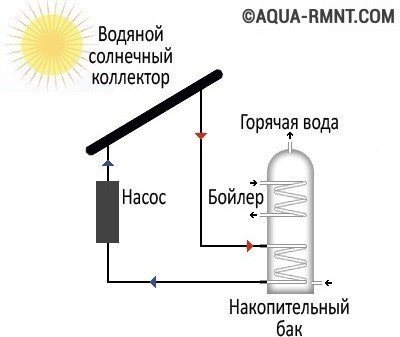

Solar hot water systems absolutely do not pollute the air and do not create noise, but their installation requires additional equipment: a pump, a pair of storage tanks, a boiler, a pipeline
The advantage of equipment operating on water collectors is environmental friendliness. Silence and clean air inside the house are just as important as heating and hot water. Before installing solar collectors, it is necessary to calculate how effective they will be in a particular case, because all the nuances are important for full operation: from the installation site to the expected power of the devices. One drawback should be taken into account - in areas with a long summer period, an excess of heated water will appear, which will have to be drained into the ground.
The importance of correct wiring diagrams
The resulting heat should be delivered to the right place in the required amount. Of course, the best solution would be to carry out thermal and hydraulic calculations, so that, according to their results, the correct distribution scheme, the diameter of pipes in all sections of the circuit, the type and number of radiators.
To balance the heating system, a control valve should be installed on each heater - a tap or a thermal head, so that in all living rooms you can set the temperature that ensures comfortable living, and make the air cooler in the back rooms.


It is the radiators that are the main heat exchangers in the rooms, therefore, in order to reduce heat loss, experts recommend insulating the distribution pipes with sleeves made of foamed polymers, and laying sheet materials that reflect heat between them and the enclosing structures.
Also, do not forget about the use of circulation pumps. The fact is that a heating system with natural circulation is much inferior in energy efficiency to pressure structures.
Infrared energy efficient heating
Often the heating season begins much later than the onset of cold weather. At the same time, the presence of heat supply does not always guarantee that the temperature regime will be optimal and comfortable.
To make it comfortable and comfortable to live in the house during the cold season, you can equip energy-saving infrared heating by purchasing special heaters. They are much more convenient than traditional radiators and have many advantages.
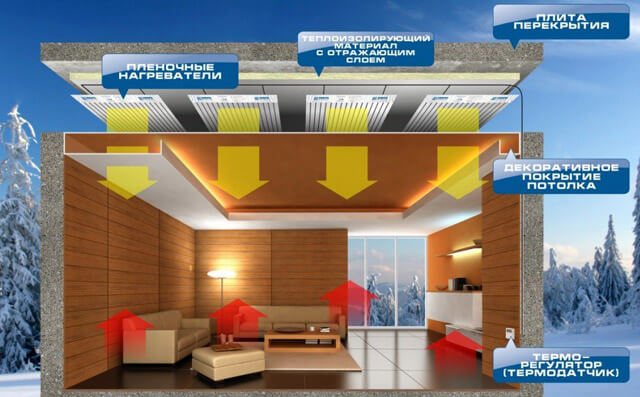

Universal infrared heating panels are highly efficient devices that meet all modern requirements - environmental, technical, economic and aesthetic.
Infrared energy-saving heating panels are installed in all types of premises, they are used as the main and additional heating. The panels are durable, reliable and fireproof, they do not corrode.
How to choose the optimal energy saving solution?
The amount of heat transfer is the main indicator that should be considered when choosing a heating medium. In the basic versions, small-sized units, like the same radiators, can quite cope with the maintenance of premises with an area of 25-35 m2. But for large living rooms, halls and rooms with high ceilings, powerful electric heating boilers are more likely to be required. The energy-saving properties of such equipment will not be so obvious, but it is important to understand that using traditional stoves and boiler stations for similar needs will be even more expensive.


High-quality home insulation for energy-efficient heating
Don't rely entirely on modern technology. The heating system will never become energy-saving if the house is not insulated to the maximum, for which:
- It is necessary to insulate the enclosing structures, especially the outer ceilings and external walls.
- Attention should be paid to openings - window and door, since through them the main loss of heat occurs. There is no need to save on windows, balcony and entrance doors; from them, you should choose the products that are most protected from heat transfer.
It is advisable to refuse to ventilate with transoms or vents, and prefer the normal option by installing adjustable inlet valves on the windows.








